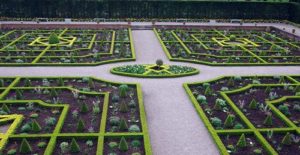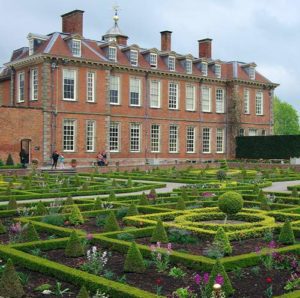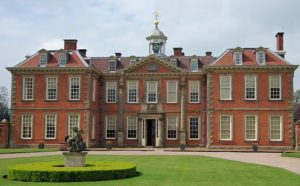We hadn’t been intending to visit Hanbury Hall on our way to Tewkesbury, but “Avoncroft Museum of Historic Buildings”:http://www.silvertraveladvisor.com/review/attraction/153123-review-avoncroft-museum-of-historic-buildings hadn’t taken us as long as we’d expected. Hanbury Hall was only a short drive away, so we decided to call in. I am so glad we did. It was a most enjoyable visit.
The hall is a lovely William and Mary brick built house with pale corner stones. The doorway is flanked by two stone Corinthian pillars which support a triangular portico. Above is a small cupola. It is a very satisfying looking house. It is surrounded by extensive grounds and a brick wall with splendid cast iron gates and two small pavilions.
The house was built in 1701 for Thomas Vernon, MP for Worcester and a lawyer. He needed a house befitting to his status and to show off to his London friends.
The ENTRANCE HALL was designed to impress with panelled walls and painted ceiling. The fireplace has the Vernon motto above with a bust of Thomas Vernon. On either side are two wooden cabinets with an inlaid Chinese pattern and with big blue and white Chinese vases on top.
The walls of the GRAND STAIRCASE were painted by Sir James Thornhill, who was responsible for the painted dome in St Paul’s Cathedral. The paintings are a series of scenes depicting Achilles going to the Trojan Wars.
On the right, wall pillars with gilded Corinthian capitals frame doorways. At the front of the house is the DRAWING ROOM with green wallpaper and red velvet curtains. It contains a small piano and table laid for tea with a crystal chandelier above. Easy chairs are arranged around the fireplace. It has a lovely marquetry floor – where it isn’t covered by a carpet.
Behind it is the DINING ROOM with yellow flock wallpaper. In the centre of the ceiling is a painting which is surrounded by a border with oak and laurel leaf panels. The huge dining table is laid with red and white china, crystal glassware and silver. At either end are two large sideboards. The fireplace has an open carved wood frieze on the walls. The picture above is set in a similar frieze and has a triangular portico with carvings of fruit and birds.
The CORRIDOR outside leads to the servants quarters and has hatchments above the doors.
The SMOKING ROOM is a small room with an easy chair in front of the fire with decanter and glass on a small table beside it. The bureau bookcase has mirrors in the doors and two small shelves that pull out from the top for candles.
Across the entrance hall is the SITTING ROOM with panelled walls painted in a pale shade of blue with framed prints. It has a plaster ceiling and a metal chandelier with tall candles. Small Chinese vases are displayed on the mantle piece. Above, on small shelves are two turquoise coloured Chinese lions. Display cases contain figurines and china baskets with flowers and fruits. A 1920s gramophone was playing period music, which brought home to us just how poor the quality was then.
The grand staircase leads to the first floor where big round arches lead into a corridor giving access to the rooms. This has a very ‘in your face’ wallpaper with a design of pillars and arches. There are old wooden seats and more display cabinets.
The BLUE BEDROOM has a four poster bed with blue drapes. At the foot is a tapestry covered settee. A bulbous chest of drawers has a marquetry pattern of flowers and there are flower paintings on the walls.
The CEDAR BEDROOM overlooks the front of the house and has deep beigy-pink panelling. The half tester bed has cream drapes with small pink flowers with blue leaves. The dressing table is laid out with brushes, combs, pair of gloves and glove stretchers. There is a small travelling writing set and on another table a small wooden tea caddy with tea pot and cup.
At the back of the house and overlooking the service courtyard is the NURSERY with doll’s house, Noah’s arc and upright grand piano. Next to it is the GOVERNESS’S DAY ROOM, a small and basically furnished room.
At the far end of the house and overlooking the parterre is the HERCULES BEDROOM. This has dark panelled walls and dark marble fireplace with chinese plates above. It is furnished with four poster bed and a small folding dressing table with a mirror and an embroidered fire screen. Off it is a small DRESSING ROOM with bureau bookcase and a jade clock on a chest of drawers.
It is then down the back stairs and out into the gardens past the tea room.
The house is surrounded by attractive grounds and some good walking if time allows. Pride of place must go to the PARTERRE which was reinstated in the 1990s. It is a large square subdivided into four smaller squares with neatly clipped low hedges and pyramidal conifers. In April the soil between the hedges was planted out with pasque flowers, London pride, hyacinths, tulips, stocks and auriculas. There are over 4000 bulbs and it takes one person 12 weeks to clip all the hedges.
Beyond is a small ORCHARD with apple trees carefully pruned into a globe shape. There are more flower beds with low clipped hedges. The orchard is surrounded by a coniferous hedge with a summer house at the far end. A gap in the hedge gives views down onto the duckpond covered with waterlilies.
The small brick built MUSHROOM HOUSE dates from 1860 and still has the slate beds used to grow mushrooms. These were being used to store apples and forced rhubarb was growing on the floor.
Next to it is the ORANGERY built in 1745, again as a status symbol when it became fashionable to grow your own lemons, limes and oranges. The large windows were designed to catch all the winter sunshine. A flue system through the walls also helped to boost winter temperatures.
Beyond is the WALLED GARDEN with beehives and hens running free. This has beds of rhubarb and chuckleberries, a cross between red currant and jostberry (Blackcurrant and gooseberry cross). These are used to flavour ice cream. Most of the garden is filled with poly tunnels used for growing plants for Hanbury Hall and other nearby NT properties.
Off the drive to the main door is a small VEGETABLE GARDEN growing broad beans, globe artichokes, sea kale, lettuce, good King Henry and Welsh onions.
The gardens are beautifully maintained by a band of volunteer gardeners as well as regular staff, and there was hardly a weed to be seen.
This was a most enjoyable visit. We liked Hanbury Hall. It is an interesting house and room stewards are good – friendly without being pushy and with a wealth of knowledge. The gardens are lovely and on a sunny day the parterre is a delightful place to sit. There is a leaflet of walks around the estate and it would be easy to spend a couple of hours exploring. The tea room is pretty good too.
ACCESSIBILITY
There is disabled parking close to the entrance in the Visitor Centre. It is a short walk to the house and a golf buggy is available to give lifts. There is wheelchair access to the ground floor in the house. The grounds and tea room are all accessible. There is a personal mobility vehicle for hire. Information is available in large print and braille.
There are more pictures “here.”:http://wasleys.org.uk/eleanor/stately_homes_castles/england/midlands/hanbury/index.html










